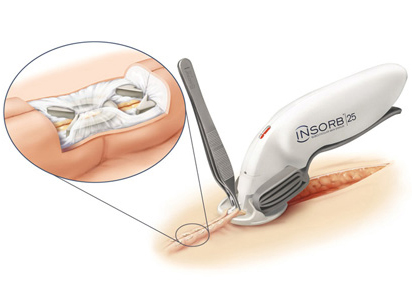
据报道斯坦福科学家发明一种血管融合技术,这种更迅速、更安全的无缝合技术可用于极细血管外科手术,给医生和病人带来了极大的方便。
在动物实验中,显微外科手术医师杰弗里·盖特纳(Geoffrey Gurtner)用一种泊洛沙姆胶(poloxamer)和生物黏合剂取代针线,将血管结合在一起,研究人员将这成为血管吻合术(vascular anastomosis)。泊洛沙姆被广泛用于各种药物运送机制中,包括化疗、疫苗和抗病毒治疗。在这项研究中,出于安全性和有效性的考量,研究人员们采用的是泊洛沙姆407。斯坦福生物材料及先进药物递送实验室的主任贾酷玛·拉加的斯(Jayakumar Rajadas)对泊洛沙姆进行了技术修改,让这种胶在体温加热下能够变得更牢固、更有弹性,而冷却时又能无害地溶解在血液中。他们用卤素灯加热胶体。
缝合手术的最大缺陷是很难用于宽度小1毫米的血管。十年前,盖特纳就在考虑找出缝合手术的替代品,以针对那些细微血管的缝合案例。2002年,当他还是纽约的一名显微外科医生时,他接到了一位年幼的患者——10到12个月大小的婴儿,婴儿的手指被自行车轮扭断了,艰难的是,患者的血管极细,甚至只有半毫米,手术共花费了5个多小时,但医生们只能为患者缝合3针。另外,缝合还会导致并发症,例如针线导致血管的内膜增生,让血管变窄等。
动物实验证实,这种方式比传统的手工缝合快5倍,即使是对超细血管(约0.2毫米宽)也一样有效,引发的炎症和疤痕也相对少了很多。盖特纳说:“这就是它的可贵之处。”在进行人体实验之前,研究人员们还要进行大量的动物测试,不过好在这项技术运用的材料早就被美国食品与药物管理局所批准。盖特纳认为,新技术具有巨大的应用潜力,尤其是在微创手术领域极为有用,它能大大缩短病人等待手术的时间。
生物探索推荐英文论文摘要:
Vascular anastomosis using controlled phase transitions in poloxamer gels
Vascular anastomosis is the cornerstone of vascular, cardiovascular and transplant surgery. Most anastomoses are performed with sutures, which are technically challenging and can lead to failure from intimal hyperplasia and foreign body reaction. Numerous alternatives to sutures have been proposed, but none has proven superior, particularly in small or atherosclerotic vessels. We have developed a new method of sutureless and atraumatic vascular anastomosis that uses US Food and Drug Administration (FDA)-approved thermoreversible tri-block polymers to temporarily maintain an open lumen for precise approximation with commercially available glues. We performed end-to-end anastomoses five times more rapidly than we performed hand-sewn controls, and vessels that were too small (<1.0 mm) to sew were successfully reconstructed with this sutureless approach. Imaging of reconstructed rat aorta confirmed equivalent patency, flow and burst strength, and histological analysis demonstrated decreased inflammation and fibrosis at up to 2 years after the procedure. This new technology has potential for improving efficiency and outcomes in the surgical treatment of cardiovascular disease.







